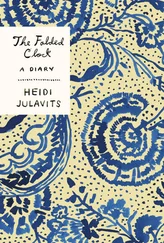The mention of “morticians” elicited a mousy sob from a woman on the bed.
Possibly-Lydia checked her bracelet watch — its loose chain necessitated a few staccato wrist rolls to bring the face into view — and said it was time to take questions from the audience.
“I found it interesting that you should raise the topic of wax museums,” said a man in suede. “Scarcity could be viewed as a romantic way to refer to manufactured celebrity. We can’t care about a person unless they’re famous. So you could accuse the people who made these films, and the people who control their distribution, of manufacturing fame for profit.”
“Not to mention emotional profit,” said a woman in a head kerchief. “All those traumatized ‘survivors.’ The collateral gains reaped by the psychiatric industry shouldn’t be underestimated.”
“I don’t understand,” said the hippie panelist. “Are you implying that the psychiatric industry is in cahoots with TK Ltd.?”
“The world of commerce is a web of interconnected extortionists,” the kerchief woman said.
A woman wearing an ethnic sweater-coat asked a question about something called “re-performance”; a theater group had secured the rights, from TK Ltd., to “re-perform” a handful of vanishing films. This had led to quite a bit of heated arguing at an earlier panel, said the sweater-coat woman.
“I was Vito Acconci’s studio assistant in the seventies,” she said. “When asked to re-perform Seed Bed , he responded, ‘If a performance is teachable and repeatable, how does it differ from theater? How are the participants not actors?’ ”
“You raise an interesting point about acting our own memories out of existence,” said Possibly-Lydia.
“It’s been estimated,” said the hippie panelist, “that seventy-five percent of the people who vanish suffer from Acquired Situational Narcissism, a syndrome that afflicts ninety-two percent of real celebrities.”
“But what kind of celebrity are we talking about here?” asked Cyndi Lauper. “How many people see these films? The more films that exist, meaning the more successful a venture TK Ltd. is, the greater the chance that a film will remain unwatched — assuming it’s not ‘re-performed’ by some low-rent theater company. Is that fame, or is that the cruelest definition of obscurity?”
“It makes me think,” said the woman who’d been crying on the bed, “of library books. I always look at the due dates stamped on the back. Sometimes, between readers, whole decades pass.”
The woman in the sweater-coat asked if TK Ltd. had anything to do with the recent rash of “surgical impersonations” she’d read about in the papers.
“People who died tragically and often young,” she explained to the room at large, “and suddenly a stranger shows up at the family’s house, a stranger who’s had his or her face surgically altered to look like the face of the dead person.”
“Strangers can be so perceptive,” said the formerly crying woman.
“TK Ltd. has nothing to do with those ‘impersonations,’ ” the probable lesbian asserted. “Also, there’s no proof that these impersonations have occurred. Most of the witnesses were severely damaged by the loss of their original loved one. Most had spent time in mental institutions.”
I raised my hand, wanting to ask if these impersonators weren’t impersonators at all, if perhaps they were restless astral imprints (a common byproduct of an accidental or a young death), returned to deal with unfinished business. But no one called on me, and it was just as well, in part because, though I publicly endorsed the theory of the young and unhappy dead, privately I’d chosen to believe that certain people might find great solace in being deceased.
Possibly-Lydia wrist-rolled her watch into view again and announced that the panel was over; she reminded people that her books were for sale in the lobby, where there would also be a cocktail reception in half an hour.
The room’s population surged toward the exit. I found myself crushed against the wall, butted by backpacks and messenger bags. I allowed myself to be pushed down the hallway and into the elevator, our collective cozy mood calcifying under the brighter scrutiny of fluorescents. We mass-flowed into the lobby and paused by the revolving door to furtively unball scarves from coat sleeves, produce gloves from hats, as though we’d all emerged from a hotel room in which we’d conducted a love affair, and now every innocuous act was tainted by embarrassment and regret.
My kneecaps bleated; I searched for a place to sit but all of the sofas and chairs were occupied by weepers. I closed my eyes and tried to ignore the garish blinking on the underside of my lids. I, too, felt embarrassed, or regretful, on the verge of dissolve. Perhaps it was the repeated (if unintentional) bumping of bags against my body, which reminded me of certain massages I’d received from physical therapists who communicated, via their cold hands and blunt, stabbing gestures, that they believed me to be a psychosomatic faker who drained from their fingertips all traces of goodwill, leaving them face-to-face with their own empathic shortfalls as healers. Or perhaps it was the crying woman’s mention of the unread library books, because truly there was nothing sadder, except a gift that a person has hand made for you, a scarf or a poncho, that, try as you might, you cannot ever see your way into wearing. This is when the cold indifference of the world envelops you, and makes you feel invigorated by emotion but also acutely alone. These moments of heartbreak for unwanted scarves and unread books can reveal to you, more than the inattention of any long dead mother, what it is to be alive.

The Regnor’s bar was located through a windowed protuberance I’d mistaken, the previous day, for a phone booth. I needed a drink, but no bartender materialized from behind the mirrored escarpment of liquor bottles.
I sat two stools over from the bar’s only other occupant, a vaguely familiar woman who held an unlit cigarette and wore a pendant that resembled a flattened mace. Perhaps, I thought, my mother’s necklaces had looked like this. I hoped so. I fetishized black-and-white photos of women in ladylike clothing and barbaric jewelry. I’d always admired a photo of Sylvia Plath wearing a cardigan and a pendant that is either a gargoyle’s face or a hazardous flower.
“Are you here for the film conference?” the woman asked. She had an Eastern European accent. With her doll eyes blinking from her scavenged face, she resembled a person buried inside another person.
“No,” I said.
“I’m an actress,” the woman offered. “Visiting from out of town.”
I smiled a force field. I was in no mood for talking.
She played with her necklace, balancing it on her pointer finger.
“My mother gave this to me,” she said. “She’s a movie director. She told me I was her muse.”
I squinted at her anew. This, perhaps, explained why she’d seemed familiar to me. No doubt she’d appeared in one of the many foreign films I’d watched since arriving in New York, my apartment located a block from a revival house that insisted on screening films without English subtitles or dubbing. I’d become gifted at extrapolating story lines without the aid of a single comprehensible line of dialogue. These movies also made me miss my psychic forays less, these oblique glimpses into the lives of cinema strangers functioning as a plausible substitute.
“Your necklace reminds me of one Sylvia Plath wore in a photo,” I said.
“The one where she was also wearing the flowered dress and the sweater?”
Читать дальше













